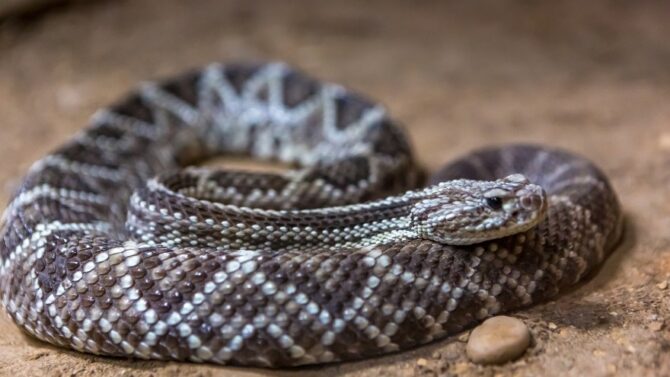Ohio, also referred to as the Buckeye state, is in Midwestern America. It is a state with fantastic options for tourists seeking a big-city experience, a quiet retreat in a small town, or a complete escape to nature.
When it comes to the history of its wildlife, Ohio has a rich and diverse one. It is home to a remarkably wide variety of birds, particularly owls.
There are 8 different species of owls in Ohio, including the majestic great horned owl, the reserved barn owl, the unaffected barred owl, the diminutive Eastern screech owl, and the covert long-eared owl, among others.
These lovely owl species of Ohio are described in this article. Read on to learn about their taxonomy, physical features, call, habitat, notable behaviors, and more.
Species of Owls In Ohio
1. Barn Owl
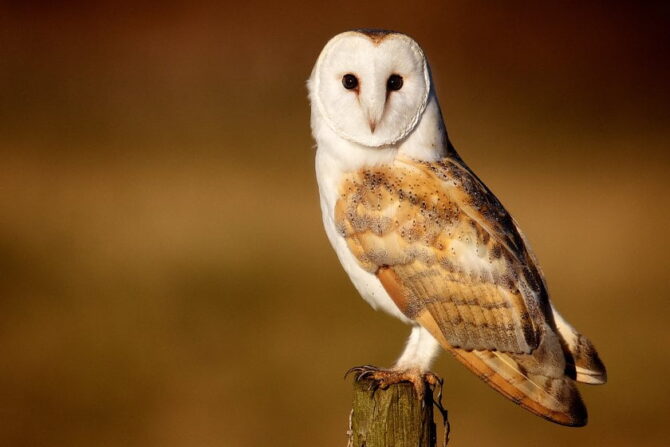
- Scientific Name: Tyto alba
- Length: 12.6 – 15.8 inches (32 – 40 cm)
- Weight: 400 – 700 g (0.9 – 1.5 lbs)
- Wingspan: 99.1 – 114.3 cm ( 39 – 45 inches)
One less common species in northern Ohio is the stunning but elusive barn owl, frequently mistaken for the barred owl due to how similar their names sound.
But physically, the two don’t resemble each other at all. The barn owl’s stunning plumage and heart-shaped face make it easily recognizable.
This owl is the most effective hunter by sound ever tested because its face directs sound to its ears.
One of the birds with the greatest global distribution is the barn owl. This owl frequently roosts in riverbanks, cliff crevices, and tree cavities.
It makes its nest in various man-made structures, such as abandoned barns, from which it got its name. Additionally, it inhabits open spaces, forest edges, clearings, farms, and urban areas.
All year long, Ohio is home to the barn owl, a strictly nocturnal and non-migratory owl. They are renowned for swallowing their prey whole, including their bones.
They will regurgitate “pellets” of the food their bodies did not require for nutrition rather than allowing it to pass through their digestive tract normally.1
Barn owls are excellent night hunters and are well-feared for their exceptional low-light vision and hearing.
More effectively than any other animal ever tested, they can locate and capture their prey solely by sound.
Unlike other owls, barn owls don’t “hoot” in the traditional way. Their distinctive screeching noise is much more akin to a red-tailed hawk.
Males occasionally clap their wings together while flying as a form of flirtation with females.
2. Barred Owl
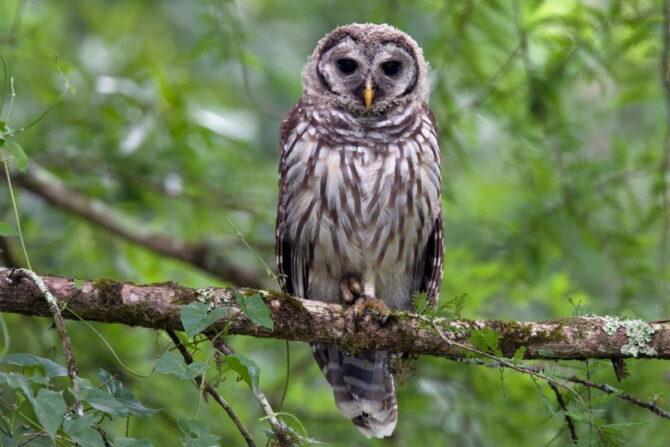
- Scientific Name: Strix varia
- Length: 16.9 – 20.1 inches (43 – 51 cm)
- Weight: 470 – 1050 g (1.0 – 2.3 lbs)
- Wingspan: 96 – 125 cm (37.8 – 49.2 inches)
The barred owl is a sizable, unthreatened, and nocturnal gray owl that can be found all year round in Ohio.
The wings, back, and tail have horizontal stripes that alternate between light and dark brown, hence the name “barred.”
Barred owls prefer old-growth forests and are frequently found close to rivers or other bodies of water. They are only sometimes easy to see, like most owls.
If you walk through a mature forest, you might be lucky and spot one roosting during the day. They are sedentary by nature and do not migrate.
The barred owls are well known for being extremely vocal and for having a call that can easily be recognized as saying, “Who cooks for you? Who cooks for you all? ”
They are incredibly inquisitive and curious and frequently watch as you pass by them. Even if they become uneasy as you get closer, they usually fly to another tree to keep watching.
3. Eastern Screech Owl

- Scientific Name: Megascops asio
- Length: 6.3 – 9.8 inches (16 – 25 cm)
- Weight: 121 – 244 g (0.27 – 0.54 lbs)
- Wingspan: 18.9 – 24.0 inches (48 – 61 cm)
The smallest and most prevalent owl in Ohio is the Eastern screech-owl. These owls can be seen all over the state, nest in tree hollows, crevices, and occasionally nest boxes. They have no necks, are short, and are stocky.
About one-third of all eastern screech owls are red, but they can also be grey. On the top of their heads, they have “fake” ear tufts.
The tufts can be moved to communicate with other owls, such as “This is a safe spot” to a mate or “Back off!” to a rival, or they can simply be used as camouflage to break up their silhouette.
These small owls can live in almost any wooded area in Ohio thanks to their excellent camouflage, but they usually stay away from areas where there are other larger owls, most notably the great horned owl.
The most well-known hoot, call, and song produced by Eastern Screech-owls is an even-pitch trill frequently referred to as a tremolo.2
The tremolo, which lasts for three to six seconds, is a communication tool used by pairs. At night, keep an ear out for their eerie trill song.
4. Great Horned Owl
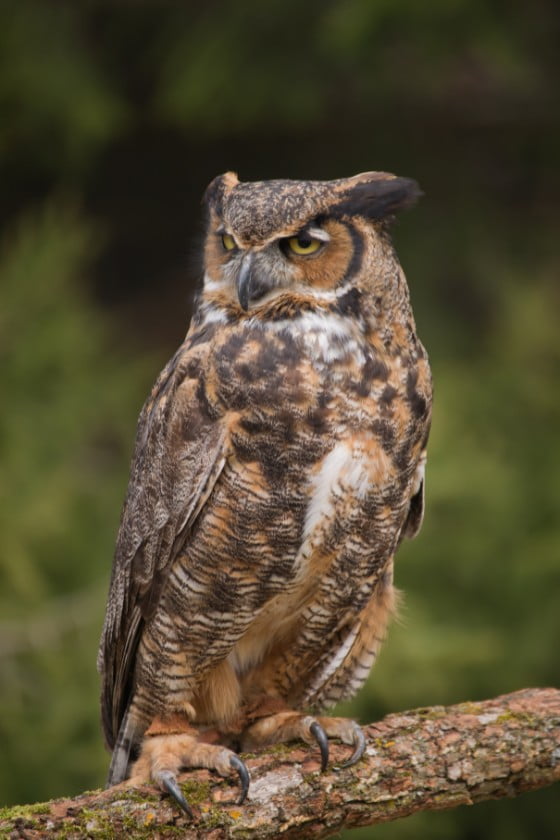
- Scientific Name: Bubo virginianus
- Length: 18.1 – 24.8 inches (46 – 63 cm)
- Weight: 910 – 2500 g (2.0 – 5.5 lbs)
- Wingspan: 39.8 – 57.1 inches (101 – 145 cm)
The great horned owl is the archetypal owl. It is a powerful predator that can devour various prey, including animals much bigger than itself.
It is the second-largest owl in Ohio and lives throughout the entire state all year. Their intimidating yellow eyes, large size, and ear tufts make them easy to identify. They are the only bird known to regularly kill and consume skunks.
A great horned owl is among the most adaptable birds there is. It is widespread in urban and suburban areas, such as cities and parks, as well as in forests, swamps, deserts, tundras, tropical rainforests, and open fields.
As long as there are trees and rocky areas where they can build nests, the great horned owl’s habitat is essentially limitless.
Both sexes hoot, though men hoot at a lower pitch than women. At night, males make audible territorial calls that can be heard a few miles away. The great horned owl is the best hooter of all owl species.
5. Long-Eared Owl
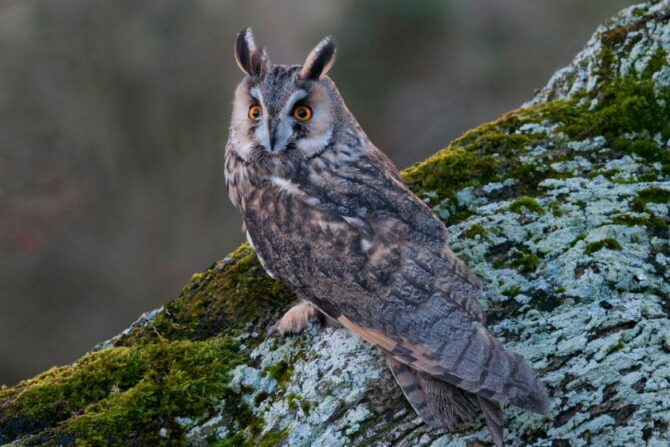
- Scientific Name: Asio otus
- Length: 13.8 – 15.8 inches (35 – 40 cm)
- Weight: 220 – 435 g (0.5 – 0.96 lbs)
- Wingspan: 35.4 – 39.4 inches (90 – 100 cm)
Because of their cat-like facial features, long-eared owls are also known as Cat owls. They can also be called the Northern long-eared owl or the Lesser horned owl.
Although you can see them hunting in open fields, they are solitary and prefer to roost in areas covered in thick vegetation.
Long-eared owls are considered permanent residents in Northeastern Ohio but are also classified as non-breeding throughout the rest of the state.
Despite being well camouflaged and potentially difficult to spot, they are easily recognized by their unusually long ears.
The long-eared owl is smaller and much lankier than the great-horned owl, despite some people mistaking it for the latter due to its prominent ear tufts.
These owls are extremely difficult to spot in Ohio due to their excellent camouflage. The lengthy feather tufts on the heads of long-eared owls give them their name. They frequently appear to be surprised because of their exclamation point-like ear tufts.
The long-eared owl is unique among owls in that it is very sociable. They have a history of living in groups and even sharing roosts.
Like the barn owl, they are ferocious and stealthy hunters who swallow their prey whole and regurgitate the unnecessary parts as pellets.
The best way to find long-eared owls is to listen because they can be very difficult to spot. Males are incredibly talkative during the mating season.
Their typical call is a low “hoo,” evenly spaced every few seconds, repeated between ten and two hundred times.
6. Northern Saw-Whet Owl

- Scientific Name: Aegolius acadicus
- Length: 7.1 – 8.3 inches (18 – 21 cm)
- Weight: 65 – 151 g (0.14 – 0.33 lbs)
- Wingspan: 16.5 – 18.9 inches (42 – 48 cm)
The Northern saw-whet owl is one of the tiniest and cutest owls to see in northern Ohio. An owl species is regarded as one of the tiniest on earth.
The reddish-brown bodies of these owls have white streaks on the belly. They also have large, yellow eyes, feathered legs and feet, dark-colored bills, and a tail with three stripes.
They have broad, rounded reddish-brown heads, and the area around their eyes is flat and grayish. White spots can be seen on their neck.
When roosting and hunting, northern saw-whet owls can blend in with their surroundings thanks to the speckles and stripes on their feathers.
Due to their extreme nocturnal habits, northern saw-whets are very elusive. They roost in dense foliage, typically just above eye level, close to the tree trunk, and are about the same size as screech owls.
They live in mature forests close to water sources and are solitary birds. These owls will use artificial nesting boxes and the more typical method, using abandoned woodpecker holes in deciduous trees for nesting.
The whetting (sharpening) sound that these owls made when alarmed gave rise to their common name.
It has the pitch of a “too-too-too” or two notes per second. The breeding season is when they make their most frequent call.
7. Short-Eared Owl
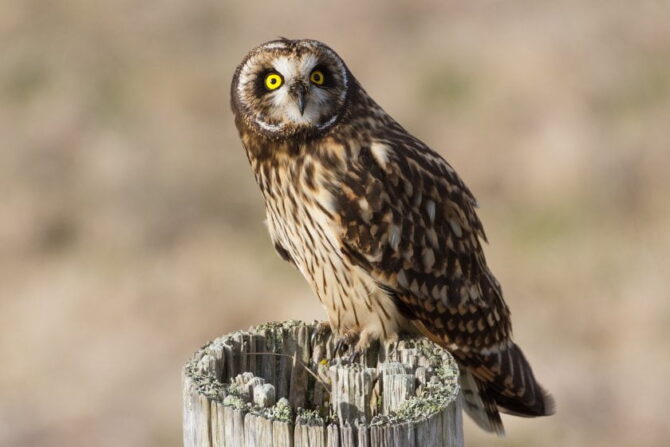
- Scientific Name: Asio flammeus
- Length: 13.4 – 16.9 inches (34 – 43 cm)
- Weight: 206 – 475 g (0.45 – 1.05 lbs)
- Wingspan: 33.5 – 40.5 inches (85 – 103 cm)
The short-eared owl is a medium-sized tawny-brown mottled owl with white and buff spots on its upper parts.
Their breasts are heavily streaked with brown, their faces are pale with yellow eyes highlighted by black outlines, and their chests and bellies are buffy or pale.
Short-eared owls live throughout North America. These birds primarily hunt during the day when their favorite prey, voles, is active. Interestingly, they are one of the most common owls seen during the day.
The non-breeding season, which lasts from late November to mid-March, is the best chance of seeing short-eared owls in Ohio.
They have a very wide distribution range in North America, from Mexico to the far north of Alaska, and they can travel great distances when they migrate.
They frequently inhabit open terrain. You can easily spot them in fields, grasslands, meadows, or even airports at dusk or dawn in Ohio.
The short-eared owl does not have a loud voice. However, when these birds make noise, their call sounds a lot like a cat trying to find a mate.
8. Snowy Owl
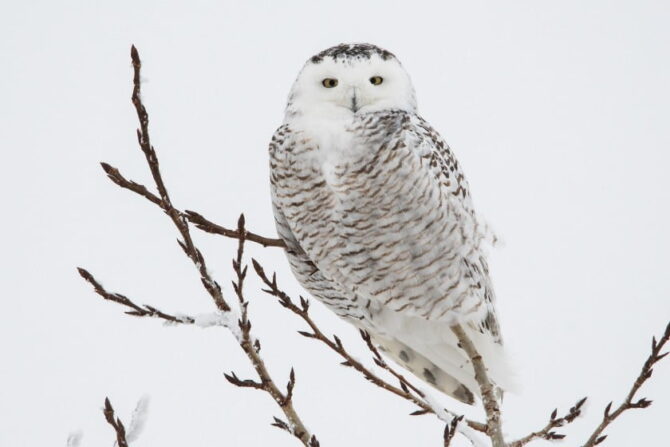
- Scientific Name: Bubo scandiacus
- Length: 20.5 – 27.9 inches (52 – 71 cm)
- Weight: 1600 – 2950 g (3.5 – 6.5 lbs)
- Wingspan: 49.6 – 57.1 in (126 – 145 cm)
By weight, the snowy owl is the biggest in North America. It is a seasonal visitor to Northern Ohio, rarely seen much further south. The Snowy owl is also one of the prettiest. These owls move and migrate with the seasons.
Their feathers vary in color from the nearly pure white of the male to the white with dark barring of the female.
They are mostly white, but on their bodies, excluding the face and breast, are horizontal, dark lines. Strangely, many of them seem to become whiter as they age.
They have rounded heads without the ear tufts of other owls, so if you see one, you can be sure it’s not any other kind.
The snowy owl is slightly larger than the great-horned owl and has stunning white feathers. It can only be found in the state’s most northern regions, although winter sightings along Ohio’s southern coasts of Lake Erie have increased in recent years.
The habitat preference of this huge owl is open spaces with minimal trees.
Males make a loud “hoo, hoo” when protecting their territory or looking for a mate. This hoot is so loud that it may be heard on the tundra from up to 7 kilometers distant.
Other sounds (for both sexes) include cackles, hissing, shrieks, and bill snapping. Females hardly ever hoot.
What are the 10 best bird-watching spots in Ohio?
Ohio is home to a variety of habitats, including fields, wetlands, marshes, forests, and prairies.
Bird watchers can observe a large number of different bird species because of the diversity of habitats. Here are the top 10 places in the state to go bird watching:
- Crown City Wildlife Area
- Pipe Creek Wildlife Area
- Woodbury Wildlife Area
- Big Island Wilderness Area
- Oak Openings Preserve Metropark
- Buck Creek State Park
- Metzger Marsh Wildlife Area
- Magee Marsh Wildlife Area
- Cuyahoga Valley National Park
- Fernald Preserve
Other Related Questions
What owl in Ohio is the biggest?
In Northeastern Ohio, the great horned owl is the biggest and strongest of the common owls.
What owl species makeup Ohio’s “Big three”?
The Eastern screech owl, barred owl, and great horned owl are the “Big three” owl species in Ohio, as they can be seen year-round.
How common are owls in Ohio?
Owls are common in Ohio. However, given their nocturnal habits and camouflaging behaviors, they can be challenging to spot.
Wrap-up
Although there are a few uncommon or accidental species from Ohio, like the burrowing owl, northern hawk owl, boreal owl, and great gray owl, the species discussed in this article are the most common ones.
They all have their different habitats, physical features, and unique characteristics.
If you’re an avid bird watcher, Ohio ought to be on your list of places to visit. We hope you enjoyed reading this.
Next up…
References & Notes
Facts Sources:
- Barn Owl Research: Barn Owl Pellets. The University of Florida.
- Pearsall K. Effects Guide: Get to Know Tremolo. Fender.




